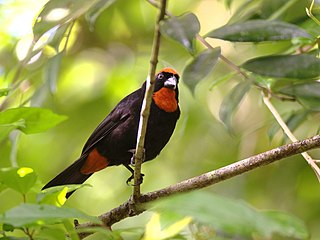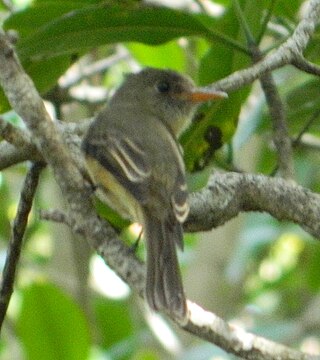
The Puerto Rican emerald, or zumbadorcito de Puerto Rico in Spanish, is species of hummingbird in the "emeralds", tribe Trochilini of subfamily Trochilinae. It is endemic to Puerto Rico.

The Puerto Rican tody is a bird endemic to Puerto Rico. It is locally known in Spanish as "San Pedrito" and "medio peso".

The Puerto Rican nightjar or Puerto Rican whip-poor-will is a bird in the nightjar family found in the coastal dry scrub forests in localized areas of southwestern Puerto Rico. It was described in 1916 from bones found in a cave in north central Puerto Rico and a single skin specimen from 1888, and was considered extinct until observed in the wild in 1961. The current population is estimated as 1,400-2,000 mature birds. The species is currently classified as Endangered due to pressures from habitat loss.

The Puerto Rican spindalis is a bird endemic to the island of Puerto Rico, where it is commonly known as reina mora. The species is widely distributed throughout the island and is an important part of the Puerto Rican ecosystem because of its help in seed dispersal and plant reproduction. The Puerto Rican spindalis is the unofficial national bird of Puerto Rico.

The yellow-shouldered blackbird, known in Puerto Rican Spanish as mariquita de Puerto Rico or capitán, is a species of blackbird endemic to Puerto Rico. It has black plumage with a prominent yellow patch on the wing. Adult males and females are of similar appearance. The species is predominantly insectivorous.

The Puerto Rican owl or múcaro común, formerly known as the Puerto Rican screech owl, is a mid-sized "typical owl" in subfamily Striginae. It is endemic to the archipelago of Puerto Rico though it formerly also inhabited the Virgin Islands.

The Puerto Rican lizard cuckoo is a species of bird in the tribe Phaenicophaeini, subfamily Cuculinae of the cuckoo family Cuculidae. It is endemic to Puerto Rico.

The fauna of Puerto Rico is similar to other island archipelago faunas, with high endemism, and low, skewed taxonomic diversity. Bats are the only extant native terrestrial mammals in Puerto Rico. All other terrestrial mammals in the area were introduced by humans, and include species such as cats, goats, sheep, the small Indian mongoose, and escaped monkeys. Marine mammals include dolphins, manatees, and whales. Of the 349 bird species, about 120 breed in the archipelago, and 47.5% are accidental or rare.

The Puerto Rican bullfinch is a small bullfinch tanager endemic to the archipelago of Puerto Rico. The species can be commonly found in heavy forests throughout Puerto Rico, except on the easternmost tip of the island. It consumes seeds, fruits, insects, and spiders. The nest is spherical, with an entrance on the side. Typically three light green eggs are laid.

The Hispaniolan woodpecker is a medium-sized woodpecker endemic to the Caribbean island of Hispaniola.

The Lesser Antillean pewee is a species of bird in the family Tyrannidae.

The Guadeloupe woodpecker or Tapeur is a species of bird in the woodpecker family Picidae belonging to the genus Melanerpes. Endemic to the Guadeloupe archipelago in the Lesser Antilles, it is a medium-sized forest woodpecker with entirely black plumage and red-to-purple reflections on its stomach. It lives mainly in the islands' tropical rainforest areas. The woodpecker has no sexual dimorphism. The species has adapted under the pressure of urbanization to more open forest environments.

The Cuban green woodpecker is a species of woodpecker in the family Picidae and tribe Melanerpini, known locally in Cuban Spanish as carpintero verde. It is the only species within the genus Xiphidiopicus and is one of two woodpeckers endemic to Cuba. It is the most widespread and common woodpecker in Cuba, inhabiting primarily woodlands, as well as dry and wet forests, pine forests and mangroves. The population of the Cuban green woodpecker is stable and its status is listed as "Least Concern".

The red fruit bat or red fig-eating bat is a species of bat in the family Phyllostomidae, in the monotypic genus Stenoderma. It is found in Puerto Rico and the U.S. Virgin Islands.

Sphaerodactylus macrolepis, also known as the big-scaled dwarf gecko or the big-scaled least gecko, is a lizard of the Sphaerodactylus genus. It was first documented in 1859 in the US Virgin Islands, specifically, St. Croix. This diurnal species has since been spotted in other locations such as Puerto Rico with major populations in Culebra.

The Puerto Rican oriole is a species of bird in the family Icteridae, and genus Icterus or New World blackbirds. This species is a part of a subgroup of orioles that includes the North American orchard oriole, Icterus spurius, and the hooded oriole, Icterus cucullatus.

The Puerto Rican sharp-shinned hawk, falcón de sierra or gavilán pecho rufo in Spanish, is an endemic subspecies of the North American sharp-shinned hawk, occurring only in Puerto Rico. Discovered in 1912 and described as a distinct sub-species, it has been placed on the United States Fish and Wildlife Service list of endangered species because of its rapidly dwindling population in Puerto Rico. It can be found in the Toro Negro State Forest.




















